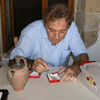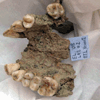Evidence of a powerful female bloodline emerges from the Iron Age necropolis of Orthi Petra at Eleutherna on Crete
![[image]](images/15.gif) |
Excavation director Nicholas Stampolidis at the entrance to a recently excavated eighth-century B.C. tomb of an important high priestess and her three female protégés, with ARCHAEOLOGY's Eti Bonn-Muller and budding archaeologist Baki Agelarakis (Photo © Prof. N. Ch. Stampolidis)
|
For a quarter century, Greek excavation director Nicholas Stampolidis and his dedicated team have been unearthing the untold stories of the people buried some 2,800 years ago in the necropolis of Orthi Petra at Eleutherna on Crete. Until now, the site has perhaps been best known for the tomb its excavators dubbed "A1K1," an assemblage of 141 cremated individuals, all but two of whom were aristocratic men who likely fell in battle in foreign lands. Excavated between 1992 and 1996, this elaborate rock-cut tomb was brimming with fantastic burial goods that date from the ninth to the seventh century B.C., including bronze vessels, gold and silver jewelry, and military regalia, as literally befits the burial of Homeric war heroes. Now, two unprecedented discoveries since 2007--three lavish jar burials that contained the remains of a dozen related female individuals and a monumental funerary building where a high priestess and her protégés, also all related, were laid to rest--are adding to our knowledge of Eleutherna's women, and forcing the scholarly community to reevaluate their importance and role in the so-called "Dark Ages" of Greece (see "Top 10 Discoveries of 2009").
History and Excavations
![[image]](images/29.gif)
A view of Mount Ida (center) from the environs of Eleutherna shows the proximity of the site to the sacred cave of Zeus, where the priestesses buried at Orthi Petra likely served the important god. (Photo by Eti Bonn-Muller)
The site of Eleutherna includes an acropolis, a polis, and a necropolis. Excavations in each area by various teams over the years have shown that the people who lived here--descendants of the Bronze Age civilizations of both the Minoans and the Mycenaeans, as well as the Dorians, warriors from the Greek mainland who settled on Crete between 1100 and 900 B.C.--controlled a vast territory, beginning around the ninth century B.C. The surrounding landscape, rich in stone, lumber, honey, and plant resources, may have played a large part in Eleutherna's economic success. The site is also strategically located, nestled in the olive-tree-dotted foothills of the sacred Mount Ida, some six miles from the sea and 10 miles from the so-called "cave of Zeus," where the head of the Greek pantheon was raised.
The Dorians wove Minoan culture into the tapestry of this cosmopolitan city. They expanded Minoan trade routes and communications with far-flung corners of the Mediterranean world, such as Asia Minor, the Middle East, North Africa, and Sicily. As the economy boomed, the landowning aristocracy grew even more powerful through taxes, its success driven yet further by the proliferation of imported luxury goods and exotic raw materials, including gold, silver, ivory, glass, and semiprecious stones, as reflected in spectacular finds from the necropolis. (See Sacred Adornments for more on the most recent discoveries.)
Stampolidis's team has unearthed three types of Iron Age burials at Orthi Petra--or "Standing Stone" (see "Introduction to Orthi Petra" video for more on the site's name)--dating from the ninth to the seventh century B.C.: pithos (large ceramic jar) burials, cremations, and basic inhumations. Over the years, stunning finds have come to light, ranging from exquisite bronze vessels to the fragile skeleton of a dog that accompanied its master to the other side. The team has also discovered funerary buildings and activity areas for cremations, including pyres straight out of verses from the Iliad.
Despite the excavation's extraordinary success, Professor Stampolidis is greatly humbled. "If you are going to do this work, you are becoming a philosopher," he says, "and you try, at least, to understand that you are just a small part of a speck of dust in oblivion."
Eti Bonn-Muller is the AIA online senior editor.
Sacred Adornments

Nicholas Stampolidis, who has directed excavations at Orthi Petra since 1985, introduces the site and shares insights into a selection of artifacts from the priestesses' tomb, including a gold pendant depicting the head of a lion--a possible hallmark of attendants to the cult of Zeus. Stampolidis is also a professor at the University of Crete and the director of the Museum of Cycladic Art in Athens.
Makings of a Matriline

Anagnostis Agelarakis of Adelphi University in New York, an archaeologist and expert in physical/forensic anthropology and paleopathology, has worked at Orthi Petra for nearly two decades. A specialist in archaeological anthropology, human ecology, and ethnography, Agelarakis has contributed to numerous excavations spanning the millennia throughout the eastern Mediterranean, and in recent years, has written for ARCHAEOLOGY (see "Warriors of Paros" and "Artful Surgery"). Follow his early analysis of the newly discovered matriline at Eleutherna.

Read an interview with Anagnostis Agelarakis.
Videos
![[image]](images/vidthumb3.gif)
Explore excavations at the necropolis of Orthi Petra through video tours with team members.
Related Features
![[image]](images/thumb2.gif)
Learn more about the archaeologically rich island of Crete through additional resources on our website.

